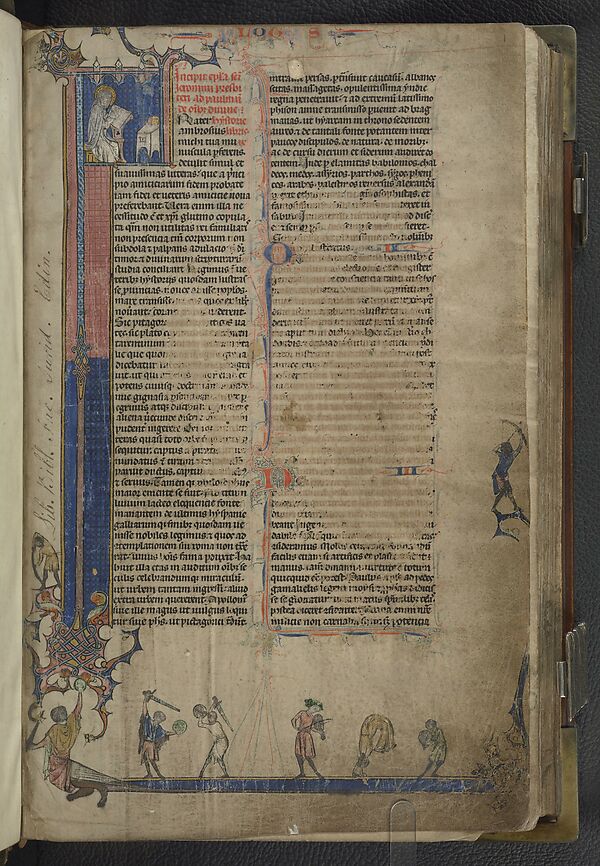Illuminated manuscripts.
Found in 154 Collections and/or Records:
Microfilm of Psalter of French provenance; and, Book of hours.
The contents are as follows:
Psalter of French provenance, 2nd half of 15th century, written for a community of Dominican nuns (MS.7122);
Book of hours, 2nd half of 15th century, probably according to the Use of Rome (MS.7124).
Microfilm of ‘Roman de la Rose’, [circa 1230, circa 1270]; and, ‘The Talbot Hours’, 15th century.
The contents are as follows:
Manuscript, late 14th or early 15th century, of ‘Roman de la Rose’, written in two stages by Guillaume de Lorris, circa 1230, and Jean de Meun, circa 1270 (Adv.MS.19.1.7);
‘The Talbot Hours’, Psalter and Hours, 15th century (Dep.221/1).
Microfilm of romance of the lovers Pamphilia and Deiphebo.
Microfilm of Sermones de Tempore, a homiliary, early 12th century; and, medical manuscripts, 13th century.
The contents are as follows:
Sermones de Tempore, a homiliary written in the early 12th century for Rochester Cathedral Priory (Adv.MS.18.2.4).
Two English medical manuscripts, each written by two scribes of the thirteenth century, bound together from an early date (Adv.MS.18.2.5).
Microfilm of the Auchinleck manuscript, a compilation of Middle English verse, including romances and religious and historical pieces.
A new master negative microfilm.
Microfilm of two calligraphic manuscripts of Esther Inglis.
Microfilm of works, 17th century, of Esther Inglis and a book of recipes, 1st half of 17th century-1735, 1879, started by Anna, Lady Elcho (died 1649).
Mid 13th-century Bible, probably written in England.
Mid-14th century manuscript of the ‘Roman de la Rose’, written in two stages by Guillaume de Lorris, circa 1230, and Jean de Meun, circa 1270
Miniature from a book of hours painted in the style of Jean Bourdichon.
Miscellany of medieval manuscripts, chiefly books of hours, which were part of a collection of manuscripts (as well as printed books and paintings) formed by William Finlay Watson, a book-seller in Edinburgh., 13th century-17th century.
In addition to the medieval manuscripts, there are some non-religious books of later date, and a few unrelated fragments.
Miscellany of medieval manuscripts, chiefly books of hours, which were part of a collection of manuscripts (as well as printed books and paintings) formed by William Finlay Watson, a book-seller in Edinburgh; together with a list of the full collection.
In addition to the medieval manuscripts, there are some non-religious books of later date, and a few unrelated fragments.
Nasta'līq manuscript, probably eighteenth century, of the history of Kashmir, by Narāyan Kūl, called 'Ājiz, composed AD 1710., 1710.
Illuminated heading on page 1. The author's name occurs on page 4.
Nasta'līq manuscript, undated, labelled on the outside "Na't wa Munājāt" ('Praise and Prayer')., ?18th century.
Papers of and concerning Phoebe Anna Traquair, artist.
As well as Phoebe Anna Traquair's correspondence, the collection comprises mainly photographs and prints depicting her murals, enamel work, illuminations and bindings.
Pauline epistles with gloss, written in France in the 12th century.
Prayers and devotional exercises., 16th century.
Psalter of Low Countries provenance., ?2nd half of 13th century.
Psalter, probably written in the area around Liège in the 14th century
'Pseaumes de David. Escrits a Londres par Esther Inglis pour son dernier adieu, ianvier, 1.1615', a calligraphic copy of the Psalms from the Geneva version of 1588, with a dedication to James VI.
The title page has an illuminated border of flowers and insects; there is a miniature of David in prayer, and a self-portrait of the scribe (folio 4), and also decorative pen-drawings of foliage.
'Ramsay psalter', written in France in the late 13th century for use at Saint Omer, and then in the possession of the Ramsay family of Colluthie
Records of Saint Ninian`s Cathedral, Perth; of the diocese of St Andrews, Dunkeld, and Dunblane; and of the Episcopal Church in Scotland.
Also included are papers of clergymen connected with Saint Ninian`s, including sermons, historical and liturgical works by Bishop Charles Wordsworth, Bishop George Howard Wilkinson, Dean George Taylor Shillito Farquar, and Dean James Wilson Harper.
Romance of the lovers Pamphilia and Deiphebo., Early 16th century.

